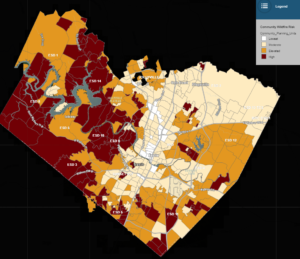Fire Resistance for Key Travis County Locations
Persistent drought, or merely a particularly dry season, makes some landscapes in Central Texas vulnerable to fire. Firewise Landscaping principles can help you create a defensible space to help save your house from wildfire.
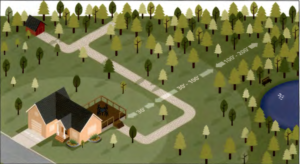
Landscaping to resist fire is an important consideration for some Travis County properties
Greenbelts and wild areas, while desirable to have property in or next to, can pose a fire hazard. The City of Austin and Travis County have an interactive map that you can use to evaluate the threat of wildfire for your neighborhood. In general, the areas where wildlands and communities meet or intermix face the highest hazard ratings.
Think Lean, Clean, Green Landscapes
The first 30 feet from your home or other structures in all directions is called your defensible space. Maintaining this defensible space is key to improving your property’s chance of surviving a wildfire.
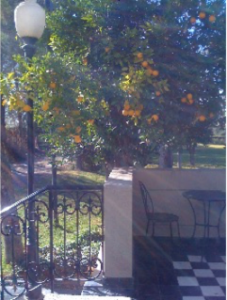
A fruit tree next to a seating area may not be ideal in a high fire hazard area. Photo courtesy of Jo Anne Hargraves
The home ignition zone can extend up to 200′ from the house in high hazard areas. This takes into account the speed that the fire can travel and the amount of hot embers and ash that it can produce.
Your main goal is to reduce the amount of fuel available and to establish areas that retard the spread of fire. Think of it as lean, clean, and green. Assess your landscaping several times a year to ensure that it fits that description. This may place limitations on the plants you select and the overall landscape design that you maintain.
How Homes Ignite
There are three main influences to cause your home or other structures to ignite: Fuel, Weather, and Terrain.
Fuel Source Influences
- Surface fuels include dry grass, shrubs, dead branches and twigs
- Ladder fuels include tall brush, low branches that carry fire from low intensity ground fire into the tops of trees called crowns or canopies
- Crown fuels are tops of trees and tall shrubs and spread rapidly and intensely
Weather Influences
- Dry, windy weather contributes significantly to the spread of wildfires
- Wind can carry firebrands (embers) up to a mile or more
- Drought conditions and low humidity lead to dry vegetation that burns easily
Terrain Influences
- Fires move more quickly uphill and have longer flames
- The direction of the slope, sunlight, and wind can impact fire behavior
Home Ignition Zones
The home ignition zone is the circular area surrounding house that can be broken into three expanding circles. Each circle is managed slightly differently in order to control the spread of fire.
Zone 1 is the first 30 ft
Zone 1 is important simply because that’s where your windows are. Do not put highly flammable plants in front of windows. High heat and embers cause plants to catch fire and burn long enough to crack the glass. The fire then enters the house through the broken windows. Here are others things to be aware of for Zone 1:
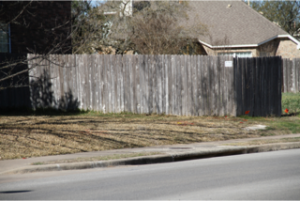
Wood fencing can serve as a fire wick. Photo courtesy of Jo Anne Hargraves
- Keep well-irrigated and free from dry vegetation or debris
- Mow lawn regularly – Green, closely mowed grass is an excellent suppressant
- Within five feet of house, use non-flammable landscaping materials such as rock, pavers, annuals and high moisture content perennials
- Inorganic mulches such as decomposed granite, gravel or rocks are best for areas that abut the house or decks (use wood chips and bark nuggets outside Zone 1)
- Keep firewood stacks and propane at least 30 ft from home
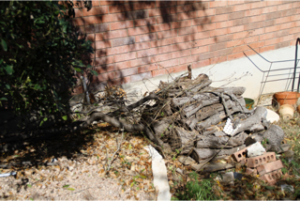
Firewood should not be stored within 30 feet of the house. Photo courtesy of Jo Anne Hargraves
- Remove dead vegetation
- Keep patio cushions inside house when not in use during periods of high fire potential
- Remove leaves from gutters
- Wood fencing between properties can serve as a wick, consider replacing with metal or stone
- Wooden decking can serve as another fire conduit, consider converting to a concrete patio with removable awnings
Zone 2 is 30-60 ft
Zone 2 is important because you want to slow the fire down before it gets near the structures. Any delay you can achieve means that fire fighters have a greater chance of reaching your property and protecting your house.
- Plants should be low-growing, well-irrigated, and less flammable
- Leave 30 ft between clusters of 2-3 trees
- Use “fuel breaks” such as driveways, gravel walkways and lawns
- Prune trees so branches and leaves are 6-10 ft above the ground
Zone 3 is 60-100 ft
Zone 3 is the buffer zone to keep embers and hot ash from reaching your home, and help to keep the fire on the ground instead of reaching tree crowns.
- Remove heavy accumulation of woody debris
- Thin trees to remove smaller conifers
- Reduce the density of tall trees so canopies are not touching
Plant Selection for Firewise Landscapes
Unfortunately, no matter how green or lush, no plant is fireproof. Plant selection plays a small part in creating a defensible barrier as part of an overall plan for firewise landscaping practices. Two characteristics to consider when selecting plants are:
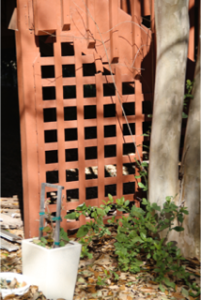
Vines and trellis structures should not be within 30 feet of the house. Photo courtesy of Jo Anne Hargraves
- Fire resistance is a measure of how readily the plant will catch fire. Generally, plants that have a high moisture content and stems that are watery and lack resins, oils, and other volatile substances are more resistant to fire. Two examples of Texas native shrubs are Black Dalea (Dalea frutescens) and Woolly Rose-mallow (Hibiscus lasiocarpos.)
- Growth characteristics describe the amount of vegetation produced by the plant. In general, plants considered more resistant to fire are low-growing or have open structures that produce fewer materials to burn. Two examples of Texas natives that fit this description are Wand Butterfly Bush (Buddlea racemosa ssp. racemosa) and American Beautyberry (Callicarpa americana.)
Plants to Avoid for Zone 1 (within 30′ of Structure)
Jo Anne Hargraves, Travis County Master Gardener and Firewise Specialist, has compiled a list of plants that should be restricted to zones 2 or 3 in order to create a defensible barrier.
Trees
- Eastern Red Cedar – Juniperus virginiana
- Arizona Cypress – Hesperocyparis arizonica
Small trees
- Texas Sabal Palm or Palmetto – Sabal minor
Small trees/Large Shrubs
- Cherry Laurel – Prunus caroliniana
- Holly, Nelly Stevens or Chinese Holly – Ilex cornuta
- Holly, Possumhaw – Ilex decidua
- Holly, Yaupon – Ilex vomitoria
- Kidneywood – Eysenhardtia texana
- Olive, Mexican – Cordia boissieri
- Palm Pindo Palm or Jelly Palm – Butia capitata
- Palm, Windmill –Trachycarpus fortunei
- Plum, Mexican – Prunus Mexicana
- Retama, Paloverde – Parkinsonia aculeata
- Viburnum-Rusty Blackhaw – Viburnum rufidulum
- Viburnum, Sandankwa – Viburnum suspensum
- Wax Myrtle – Morella cerifera
Small Shrubs
- Agarita – Mahonia trifoliata)
- Aralia, Japanese – Fatsia japonica
- Barbados,Cherry – Malpighia glabra
- Bottlebrush – Callistemon citrinus
- Elaeagnus – Elaeagnus pungens
- Flame acanthus – Anisacanthus quadrifidus
- Holly-all varieties
- Honeysuckle Bush, White – Lonicera albiflora
- Oleander-Nerium – Nerium oleander
- Palmetto, Texas dwarf – Sabal minor
- Rosemary, Upright – Salvia rosmarinus
- Sage, Texas (Cenizo) – Leucophyllum frutescens
- Skyflower – Duranta erecta
- Sumac, fragrant (aromatic) – Rhus aromatica
Perennials
- Gayfeather – Liatris punctata var. mucronata
- Oregano, Mexican – Poliomintha longiflora
- Sage, Mexican bush – Salvia leucantha
- Basket Grass (Sacahuista, Texas Beargrass) – Nolina texana
- Fountain grass, dwarf – Pennisetum alopecuroides
- Mexican Feathergrass (Wiregrass) – Nassella tenuissima
- Muhly, Bamboo – Muhlenbergia dumosa
- Muhly, Big – Muhlenbergia lindheimeri
- Muhly, Gulf – Muhlenbergia capillaris
- Muhly, Deer – Muhlenbergia rigens
- Muhly, Pine – Muhlenbergia dubia
Vines
- Carolina Jasmine – Gelsemium sempervirens
- Coral Vine – Antigonon leptopus
- Fig Vine – Ficus pumila
- Jasmine, Confederate – Trachelospermum jasminoides
- Wisteria, Evergreen – Millettia reticulata
- Wisteria, Texas – Wisteria frutescens
Ground Cover
- Rosemary, trailing – Salvia rosmarinas Var. prostrates
- Santolina (Lavender Cotton) – Santolina chamaecyparissus
- Sedge, Berkeley – Carex tumulicola
- Sedge, Blue – Carex flacca
- Sedge, Cherokee – Carex cherokeensis
- Sedge, Meadow – Carex perdentata
- Sedge, Texas – Carex texensis
High Flammability Plants to Consider Avoiding for all Zones
These plants are highly flammable due to volatile oils or growth habit. If you live in a neighborhood that is susceptible to wildfire, consider avoiding these altogether.
- Eastern red cedar
- Arizona Cypress
- Palmetto or any type of palm
- Hollies
- Ornamental grasses
- Sedges
- Rosemary
- Santolina
Additional Resources For Firewise Landscaping
Firewise Landscaping in Texas from Texas A&M Forest Service
Wildfire – Best Environmental Practices from City of Austin Watershed Protection
Find Your Emergency Services District
Travis County Wildfire Hazard Areas Map
Landscaping & Lawns main page
